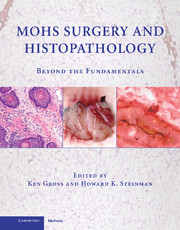PART II - INTRODUCTION TO LABORATORY TECHNIQUES
Published online by Cambridge University Press: 03 March 2010
Summary
AFTER EXCISION, the Mohs specimen is normally placed on gauze or other media having a defined and visible 12 o'clock reference mark that corresponds to that of the specimen and the Mohs map. The specimen is left whole or subdivided into smaller pieces, based on its size and surgeon preference. It is then left to lay flat, chromacoded by the surgeon or technician, and processed into pathology slides by frozen sectioning. The slides are stained with hematoxylin and eosin (H&E) or toluidine blue and delivered along with the map to the Mohs surgeon who performed the surgery.
As the popularity of Mohs surgery has grown, so has the demand for concrete knowledge of practical, efficient, and effective Mohs tissue processing techniques. Chapters 6, 7, and 8 are intended to serve as a reference for making high-quality Mohs slides. They will also discuss structural changes that occur when tissue is processed and how knowledge of these phenomena can improve the slides produced. The techniques and pearls discussed are based on the author's personal experiences over the past 15 years.
Of all the assets at a Mohs technician's disposal, the most important is “frame of mind.” When processing tissue, technicians must assume that anything that might go wrong to yield a negative outcome is in their control and is a direct result of their handling of the specimen or equipment. Keep an open mind and assume self-fault to constantly improve.
- Type
- Chapter
- Information
- Mohs Surgery and HistopathologyBeyond the Fundamentals, pp. 35 - 36Publisher: Cambridge University PressPrint publication year: 2009



